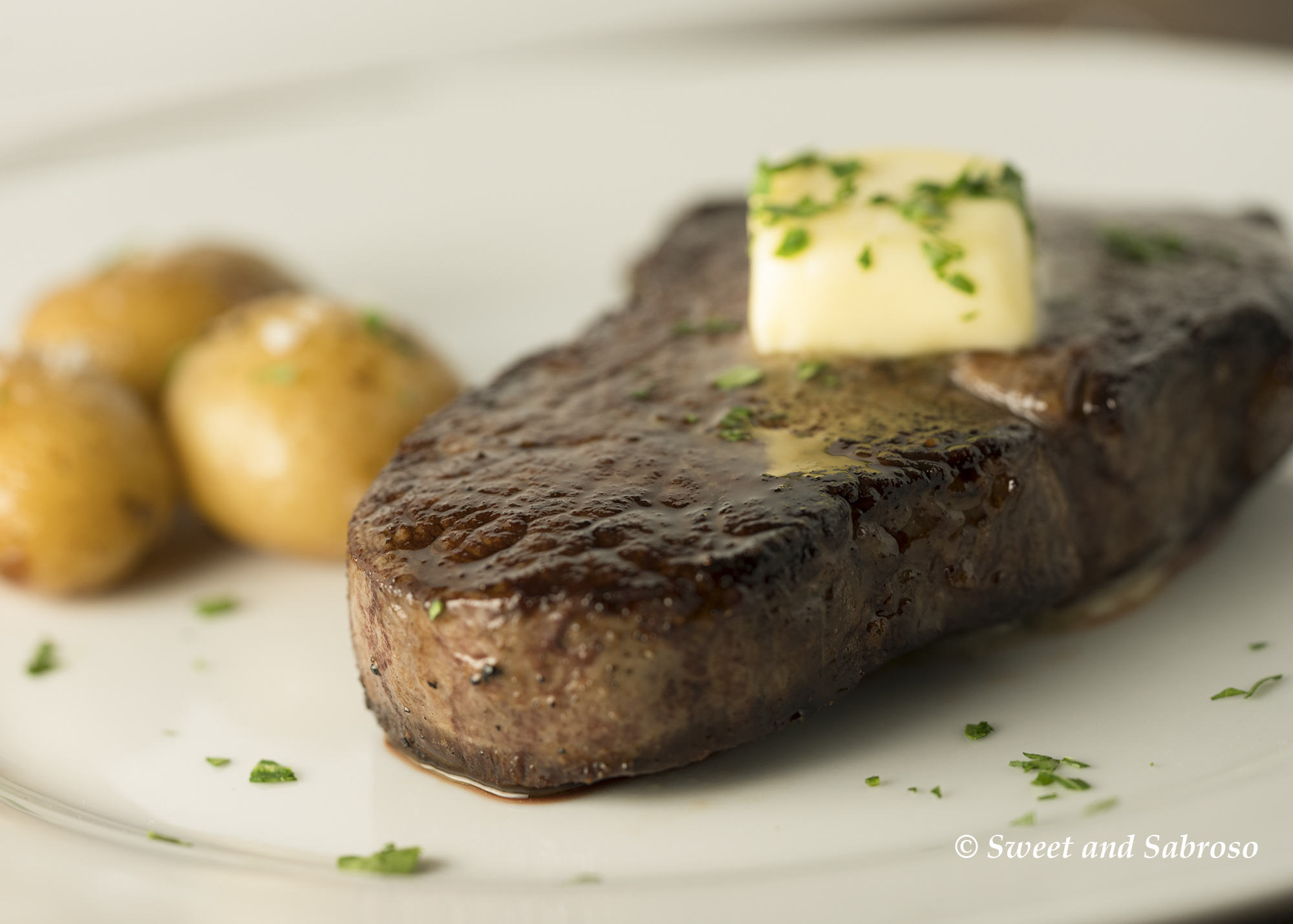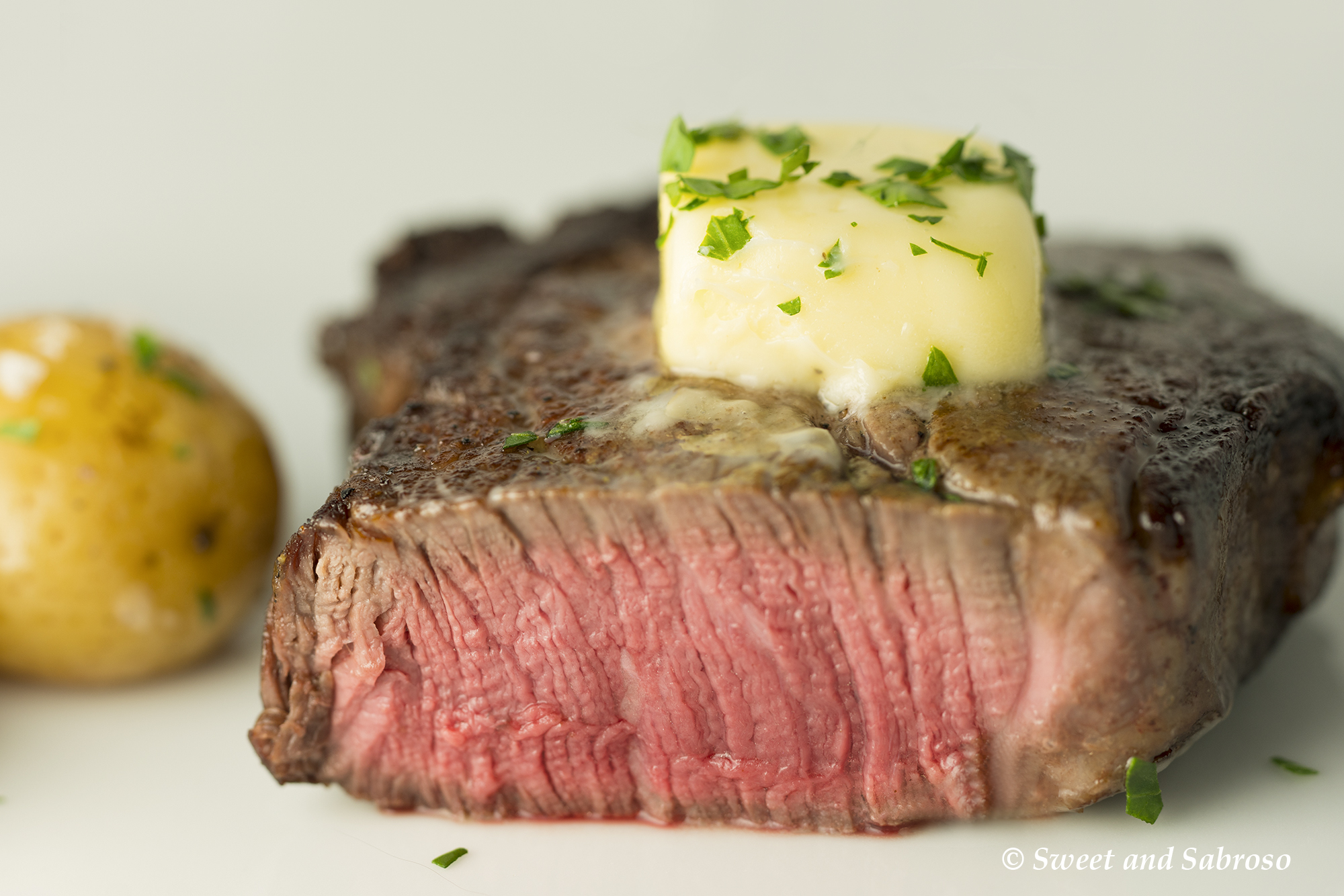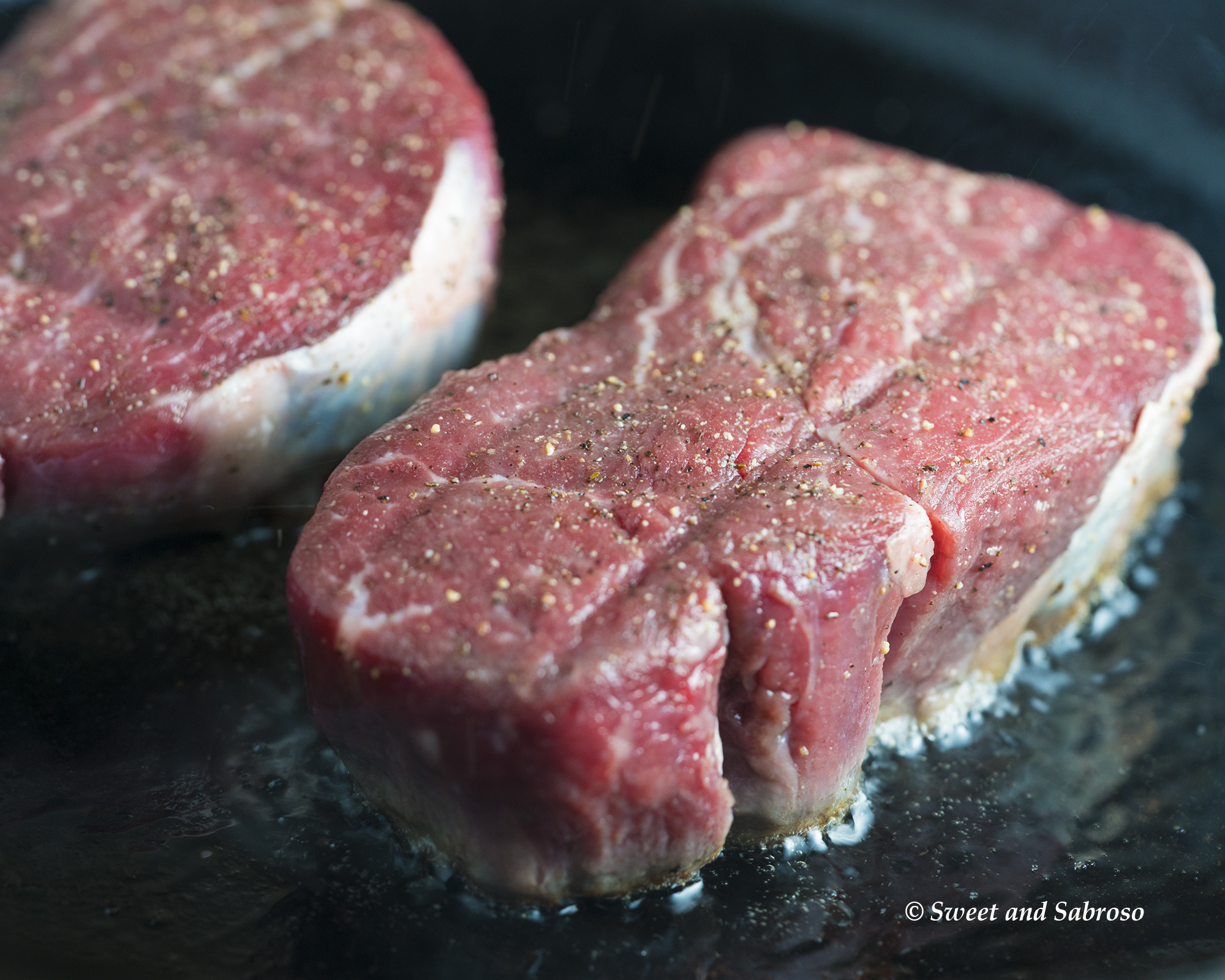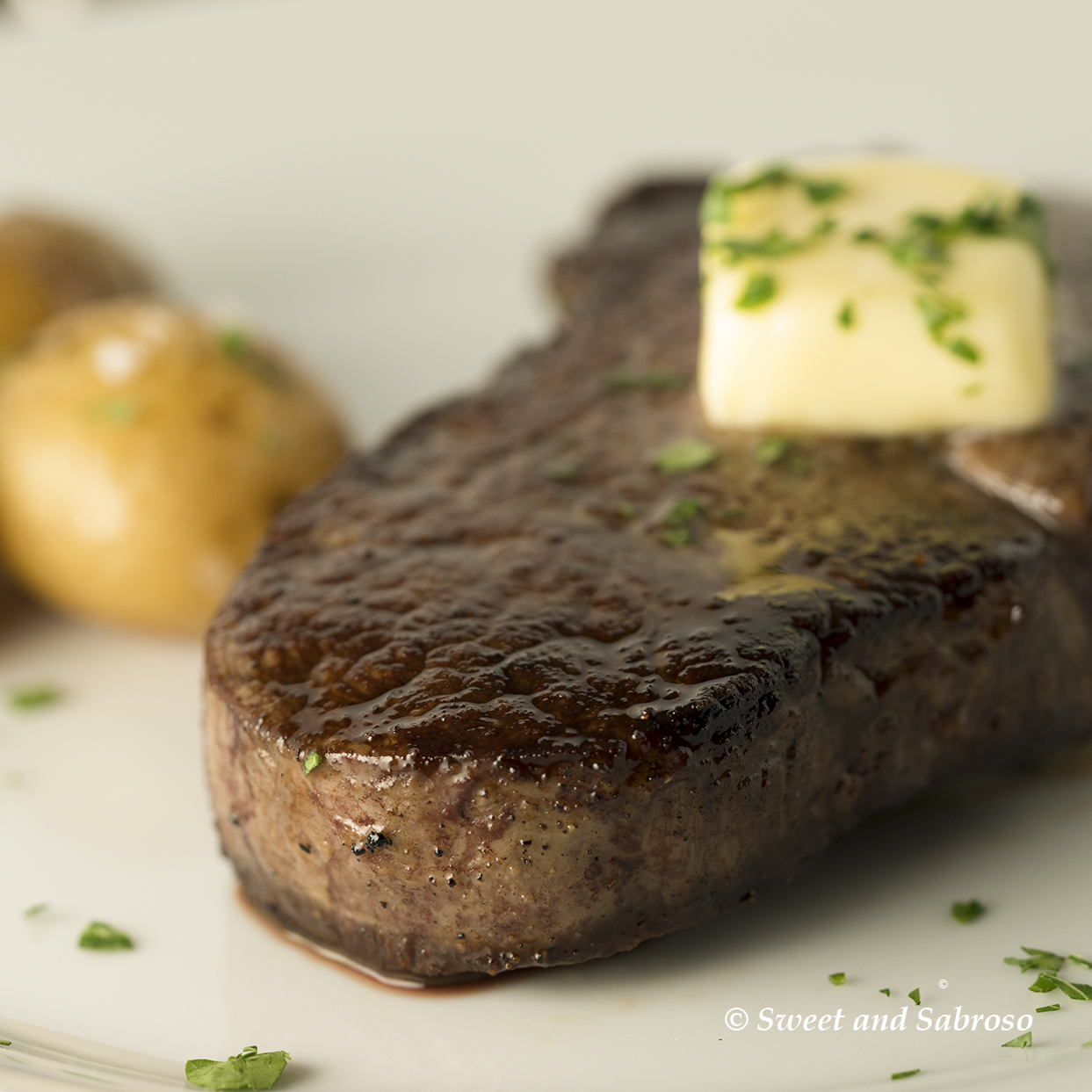This Perfect Pan Seared Restaurant Style Filet Mignon for Two is our go-to recipe for a romantic dinner, special occasion or when we just feel like a restaurant-quality steak at home. Our pan-searing to oven method results in a perfectly cooked steak that’s tender and juicy with a delicious golden-brown caramelized crust. Serve them with our Creamy Cauliflower Purée with Manchego Cheese and Olive Oil (and p.s. don’t forget the red wine – see our wine pairing suggestions below!).

Recipe Notes✏
Beef Quality: Prime, Choice or Select?
We strongly believe in using the best quality ingredients reasonably available, and of course, subject to budget considerations. This is especially important for our Perfect Pan Seared Restaurant Style Filet Mignon for Two recipe because the filet mignon is seasoned only with salt and pepper and there is no heavy sauce to mask the flavors of the meat.
In the United States, the U.S. Department of Agriculture (USDA) inspects all meat for wholesomeness, and upon the request of producers and processors, grades meat for quality. As described by the USDA Food Safety and Inspection Service, there are eight total quality grades for beef:
USDA PRIME: is produced from young, well-fed beef cattle. It has abundant marbling and is generally sold in restaurants and hotels. Prime roasts and steaks are excellent for dry-heat cooking (broiling, roasting, or grilling).
USDA CHOICE: is high quality, but has less marbling than Prime. Choice roasts and steaks from the loin and rib will be very tender, juicy, and flavorful and are, like Prime, suited to dry-heat cooking. Many of the less tender cuts, such as those from rump, round, and blade chuck, can also be cooked with dry heat if not overcooked. Such cuts will be most tender if “braised” – roasted, or simmered with a small amount of liquid in a tightly covered pan.
USDA SELECT: is very uniform in quality and normally leaner than the higher grades. It is fairly tender, but, because it has less marbling, it may lack some of the juiciness and flavor of the higher grades. Only the tender cuts (loin, rib, sirloin) should be cooked with dry heat. Other cuts should be marinated before cooking or braised to obtain maximum tenderness and flavor.
Standard and Commercial grades: are frequently sold as ungraded or as “store brand” meat.
Utility, Cutter and Canner grades: are seldom, if ever, sold at retail but are used instead to make ground beef and processed products.
In short, when pan searing filet mignon, buy Prime beef if you can! If not, Choice is a good second choice (pun intended!). Don’t bother with Select.

When to Salt Your Steaks
It’s well-known that you should salt your steaks prior to cooking for a number of good reasons, but exactly when to do it is the subject of much debate. Some people salt their steaks right before cooking, others do it a few minutes or hours before, and yet others do it days before (a process called dry aging).
For years, we were in the salt-a-few-minutes-before camp, until we incorporated tips from The Food Lab, written by J. Kenji López-Alt. In this article of The Food Lab, Kenji recommends salting your steaks at least 40 minutes and up to overnight before cooking.
We have yet to try salting overnight or dry aging (we will keep you posted when we do!), but we have salted our steaks 40-45 minutes prior to cooking with great success. Unlike our former salting-a-few-minutes-before routine (which too often resulted in an internally under-seasoned steak with a salty crust), salting our steaks 40-45 minutes prior to cooking allows the salt to better penetrate the meat, making it more flavorful on the inside as well as the outside.
Accordingly, our recipe for Perfect Pan Seared Restaurant Style Filet Mignon for Two calls for salting the steaks 45 minutes prior to cooking. If you don’t have time for this, Kenji recommends salting the steaks immediately before cooking, and make sure to avoid cooking them anywhere between 3 and 40 minutes after salting.
Bringing Steaks to Room Temperature Before Cooking
Most recipes recommend to take your steaks out of the refrigerator about 20 to 30 minutes before cooking in order to ensure they cook evenly. This theory has been debunked by many in recent years, as described in this article of Cooking Light and this article of The Food Lab. Despite such evidence, since we have not personally debunked the theory, and until we do, we’ll err on the side of caution and take our steaks out of the fridge early. Old habits die hard, sometimes.
Pan-Searing to Oven Method
Our recipe for Perfect Pan Seared Restaurant Style Filet Mignon for Two calls for pan-searing the steaks at high heat, which through a series of chemical reactions known as the Maillard reaction, adds flavor and a nice golden-brown color to the steaks. Ensuring that the steaks are dry by patting them with paper towel and placing them on a rack in the refrigerator also helps achieve a nice even sear on the steaks. Due to the thickness of the steaks (approximately 2 inches), they are finished in the oven to cook them through to medium-rare without drying the outside.

Meat Internal Temperature Guide
For maximum accuracy, to determine if our steaks are done to our liking (medium-rare), we prefer to use an instant-read digital thermometer, a ThermaPen from ThermoWorks, and the following guide derived from ThermoWorks’ Chef-Recommended Temps. If you like your steaks cooked to a different temperature, feel free to use this guide, but remember that these are final cooked temperatures. You will need to remove your steaks from the heat at about 5 degrees lower, as temperatures will continue to rise during resting (which we discuss under the next subheading).
- RARE: 120 to 130°F
- MEDIUM-RARE: 130 to 135°F
- MEDIUM: 135 to 145°F*
- MEDIUM-WELL: 145 to 155°F
- WELL DONE: 155°F and up
*145°F is the safe minimum internal temperature recommended by the USDA.
Resting Steaks After Cooking
A little patience before eating your steak goes a long way! Steaks need to rest after cooking so that the muscle fibers relax and the juices can be reabsorbed and redistributed into the meat. If you don’t rest your steak, the juices will flow right out when you cut into it. The amount of resting time depends on the size of the cut, but typically it’s about 10 minutes for a steak that is 2 inches thick.
Recipe 🍽

Perfect Pan Seared Restaurant Style Filet Mignon for Two

- • 2 8-ounce filet mignon steaks, about 2 inches thick
- • kosher salt to taste
- • freshly ground black pepper to taste
- • grapeseed or vegetable oil for frying
- • 2 tablespoons unsalted butter, separated (optional)
- • finely chopped parsley for garnish (optional)
Step 1: 45 minutes prior to cooking, thoroughly pat the steaks dry with paper towel. Season the steaks generously with salt and pepper on all sides, gently pressing the salt and pepper into the steaks with your fingertips. Place steaks on a rack and store in the refrigerator.
Step 2: 20 minutes prior to cooking, remove the rack with the steaks from refrigerator.
Step 3: Preheat oven to 400° F
Step 4: Add frying oil to a cast iron skillet or other heavy-bottomed oven-safe pan and heat over high heat until the oil begins to smoke. Add the steaks to the pan, and cook on one side without moving until a golden-brown crust forms (about 3-4 minutes).
Step 5: Using tongs, sear the edges of each steak until brown (about 2 minutes) and turn over so the uncooked side is down. Using oven mitts, immediately transfer pan to the oven and continue to cook until an instant-read thermometer inserted into the thickest part of each steak registers 125°F for medium-rare (about 4-5 minutes) or desired doneness.
Step 6: Transfer the steaks to a large plate, top with butter (if using), tent loosely with aluminum foil and allow to rest for 10 minutes. Garnish with parsley (optional).
Wine Pairings🍷
Steak and red wine are a classic pairing. A steak with a significant amount of marbling, like a ribeye, can stand up to a big, bold red wine with high levels of tannin and acidity. Since filet mignon is a leaner cut than ribeye, a big, bold red wine may overwhelm it, so we would avoid overly tannic or acidic wines, such as many Italian reds.
However, the wine should have some structure and body to complement the steak, so we would recommend pairing it with a Rioja Crianza or Reserva, Merlot or Cabernet Sauvignon. We would also avoid youthful, fruit-forward red wines, such as Spanish Garnacha (Grenache) or Pinot Noir wines that haven’t been aged (or were aged for short periods) in oak, as their delicate flavors may be overwhelmed by the flavors of the steak.
But, as always, these are only our opinions. The only wine pairing that matters is what you like!
Enjoy, and thank you for visiting!
!Salud!
















